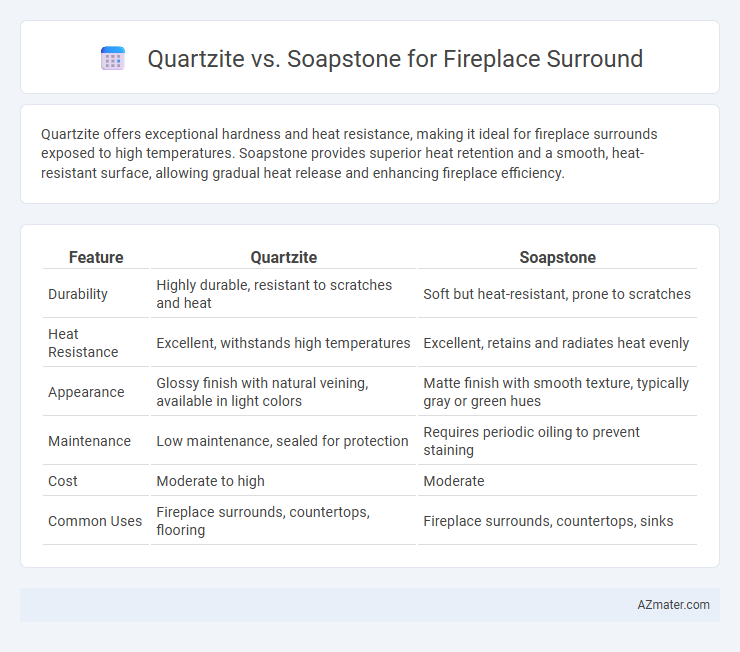Quartzite offers exceptional hardness and heat resistance, making it ideal for fireplace surrounds exposed to high temperatures. Soapstone provides superior heat retention and a smooth, heat-resistant surface, allowing gradual heat release and enhancing fireplace efficiency.
Table of Comparison
| Feature | Quartzite | Soapstone |
|---|---|---|
| Durability | Highly durable, resistant to scratches and heat | Soft but heat-resistant, prone to scratches |
| Heat Resistance | Excellent, withstands high temperatures | Excellent, retains and radiates heat evenly |
| Appearance | Glossy finish with natural veining, available in light colors | Matte finish with smooth texture, typically gray or green hues |
| Maintenance | Low maintenance, sealed for protection | Requires periodic oiling to prevent staining |
| Cost | Moderate to high | Moderate |
| Common Uses | Fireplace surrounds, countertops, flooring | Fireplace surrounds, countertops, sinks |
Introduction to Quartzite and Soapstone Fireplace Surrounds
Quartzite is a natural stone formed from sandstone under intense heat and pressure, providing exceptional hardness and resistance to heat, making it ideal for fireplace surrounds. Soapstone, a metamorphic rock rich in talc, offers excellent heat retention and a soft, smooth texture that darkens over time, creating a warm and inviting ambiance. Both materials deliver durable and visually appealing fireplace surrounds, with quartzite emphasizing strength and soapstone highlighting heat absorption.
Aesthetic Differences: Quartzite vs Soapstone
Quartzite offers a striking, glassy finish with vibrant veining patterns that create a dynamic and contemporary look for fireplace surrounds. Soapstone features a softer, matte texture with subtle veining, contributing a rustic, timeless appeal and excellent heat retention properties. The choice between quartzite and soapstone hinges on whether a bold, modern aesthetic or a warm, classic ambiance is desired for the fireplace design.
Durability and Heat Resistance Comparison
Quartzite offers exceptional durability and scratch resistance, making it ideal for high-traffic areas, while its natural ability to withstand high temperatures ensures long-lasting performance as a fireplace surround. Soapstone, known for its superior heat retention and thermal shock resistance, efficiently absorbs and radiates warmth but is softer and more prone to scratches and dents compared to quartzite. Choosing between quartzite and soapstone for a fireplace surround depends on prioritizing either hardness and long-term durability or heat retention and resilience to rapid temperature changes.
Maintenance Needs: Quartzite vs Soapstone
Quartzite requires periodic sealing to prevent stains and maintain its polished surface, making its maintenance moderate but essential for durability. Soapstone is naturally non-porous and heat-resistant, requiring minimal upkeep, as it does not need sealing and can be easily cleaned with mild soap and water. Choosing soapstone reduces long-term maintenance efforts, while quartzite demands more attention to preserve its aesthetic qualities around a fireplace surround.
Pros and Cons of Quartzite Fireplace Surrounds
Quartzite fireplace surrounds are highly durable and resistant to heat, making them an excellent choice for high-temperature areas like fireplaces. Their natural hardness prevents scratches and etching, but the surface can be prone to chipping if not handled carefully during installation. Although quartzite offers a sleek, polished appearance similar to marble, it generally requires periodic sealing to maintain its stain resistance over time.
Pros and Cons of Soapstone Fireplace Surrounds
Soapstone fireplace surrounds offer superior heat retention and a smooth, non-porous surface that resists stains and requires minimal maintenance. Its softer composition makes it easier to carve and install but also more prone to scratching and chipping compared to the harder, more durable quartzite. While soapstone provides a natural, warm aesthetic with excellent thermal properties, its higher cost and potential for surface damage may influence the choice for fireplace surrounds.
Cost Comparison: Quartzite vs Soapstone
Quartzite generally costs between $70 and $120 per square foot, making it a more expensive choice for fireplace surrounds compared to soapstone, which typically ranges from $50 to $90 per square foot. Installation costs for quartzite can also be higher due to its hardness and brittleness, requiring specialized tools and labor, whereas soapstone's softer nature allows for easier cutting and installation, reducing overall expenses. Long-term maintenance costs favor soapstone, as it resists staining and heat damage better than quartzite, potentially lowering repair and upkeep costs over time.
Installation Considerations for Both Materials
Quartzite requires professional installation due to its hardness and density, demanding specialized tools for cutting and shaping to avoid chipping. Soapstone is softer and more workable, allowing for easier customization and less risk of damage during installation, but it also needs sealing to prevent staining. Both materials benefit from a stable, well-prepared substrate to ensure long-term durability and heat resistance in fireplace surrounds.
Design Versatility and Style Options
Quartzite offers a wide range of colors and patterns, providing exceptional design versatility for fireplace surrounds that can complement both modern and traditional decors. Soapstone features a smooth, matte finish with earthy tones, delivering a warm, rustic style that ages beautifully over time. Both materials allow for customization, but quartzite's high gloss and diverse palette make it especially suited for bold, contemporary aesthetics.
Which is Better for Your Fireplace Surround: Quartzite or Soapstone?
Quartzite offers exceptional durability and heat resistance, making it ideal for fireplace surrounds exposed to high temperatures and frequent use, while its natural quartz composition ensures a sleek, polished aesthetic. Soapstone provides superior heat retention and a softer, more rustic appearance, but it is softer and more prone to scratches and dents compared to quartzite. For a fireplace surround combining longevity and minimal maintenance, quartzite is generally the better choice, whereas soapstone suits those seeking a unique, warm texture with excellent heat absorption.

Infographic: Quartzite vs Soapstone for Fireplace Surround
 azmater.com
azmater.com